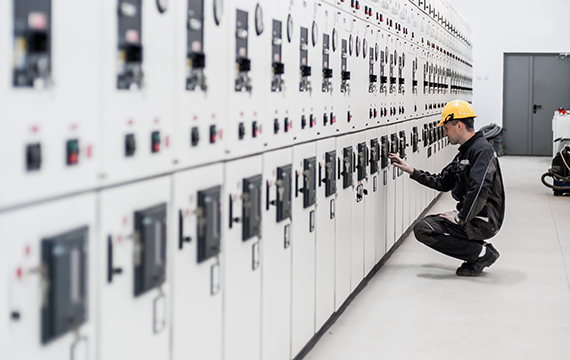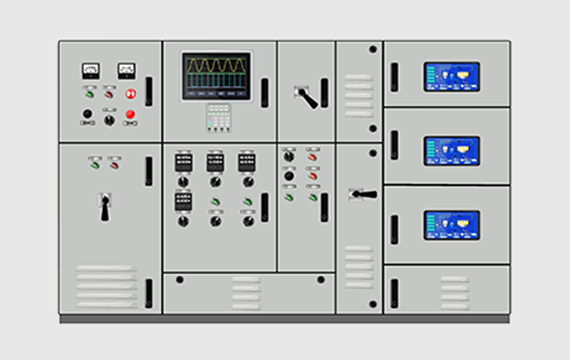What is Switchgear? A Complete Guide
1. Introduction to Switchgear
What is Switchgear?
At its core, switchgear is a centralized collection of electrical disconnect switches, fuses, and circuit breakers. These components are used to control, protect, and isolate electrical equipment. Think of it as a crucial intermediary between your power source and the devices or systems that use that power.
Why is Switchgear Essential In Electrical Systems?
Imagine an electrical grid without any safeguards. A fault, like a short circuit, could lead to widespread damage, fires, or even explosions. This is where switchgear steps in. It ensures the safety of both personnel and equipment by quickly interrupting fault currents. Beyond safety, it enables reliable power distribution, allowing maintenance crews to safely work on specific sections of a grid without shutting down the entire system.
A Quick Look at Switchgear’s History
The concept of switchgear isn’t new! Early forms date back to the late 19th century when electricity started becoming widespread. Initially, it was simple open-air disconnects. Over time, as electrical systems grew more complex and powerful, the need for safer, more enclosed, and automated solutions became critical. This led to the development of sophisticated circuit breakers, protective relays, and the highly reliable systems we see today.
2. Functions of Switchgear
- Switching and Isolation: It allows you to safely connect or disconnect electrical circuits. This is vital for routine operations, maintenance, or when you need to de-energize a section for repairs.
- Protection: This is arguably its most critical role. Switchgear protects electrical equipment (like transformers, motors, and generators) from damaging overcurrents, short circuits, and ground faults by rapidly interrupting the flow of electricity when an issue arises.
- Control: It provides the ability to manage and regulate the flow of power within a system, ensuring electricity goes where it’s needed, when it’s needed.
- Metering and Monitoring: Modern switchgear often includes instruments to measure voltage, current, power, and other parameters, giving operators real-time insights into system performance.
3. Key Components of Switchgear
3.1 Circuit Breakers
These are the heroes of protection! Circuit breakers are mechanical switching devices that can make, carry, and break normal load currents, and also break short-circuit currents. They can be reset after a fault, unlike fuses. You’ll find various types, including air, vacuum, and SF6 (sulfur hexafluoride) circuit breakers, each suited for different voltage levels and applications.
3.2 Switches
Simpler than circuit breakers, switches are primarily used for making and breaking circuits under normal operating conditions, not typically for fault interruption. Disconnect switches (or isolators) are used to create a visible break in a circuit for safety during maintenance. Load break switches can interrupt current under normal load conditions.
3.3 Fuses
An older but still effective form of protection, fuses are sacrificial devices that melt and open a circuit when an overcurrent flows through them. They’re typically a one-time use component for fault protection.
3.4 Relays
These are the “brains” that detect abnormal conditions. Protective relays sense faults (like overcurrent or undervoltage) and send a trip signal to the circuit breaker to open the circuit. Control relays are used for operational logic within the system.
3.5 Busbars
Think of busbars as the electrical highways within the switchgear. They are conductors (usually copper or aluminum bars) that collect electrical power from incoming circuits and distribute it to outgoing circuits.
3.6 Control Panels and Instrumentation
This is where operators interact with the switchgear. Control panels house the relays, meters, indicators, and control switches that allow monitoring and manual operation of the system.
3.7 Enclosures
The enclosures are the robust metal cabinets that house all the internal components. They provide physical protection against environmental factors (dust, moisture) and, crucially, safety for personnel by preventing accidental contact with live parts. They also play a role in containing arc flashes if a fault occurs.
4. Types of Switchgear
4.1 Classification by Voltage Level
- Low Voltage (LV) Switchgear: Typically used for voltages up to 1 kV. You’ll find this in commercial buildings, industrial plants, and even residential applications. It’s common for motor control centers and main distribution boards.
- Medium Voltage (MV) Switchgear: Covers voltages from 1 kV to 38 kV. This is widely used in power distribution networks, large industrial facilities, and substations.
- High Voltage (HV) Switchgear: For voltages above 38 kV, extending up to hundreds of thousands of volts. This is primarily found in transmission substations and power generation facilities, handling the bulk transfer of electricity over long distances.
4.2 Classification by Insulation Medium
- Air-Insulated Switchgear (AIS): Uses air as the primary insulating medium. It’s robust and widely used, but requires more space than other types.
- Gas-Insulated Switchgear (GIS): Uses sulfur hexafluoride (SF6) gas for insulation. GIS is much more compact and ideal for space-constrained areas, as SF6 has excellent insulating properties.
- Vacuum-Insulated Switchgear (VIS): Employs a vacuum as the insulation and arc-extinguishing medium. It’s often found in medium voltage applications due to its environmental friendliness and long service life.
- Oil-Insulated Switchgear: An older technology where oil is used for insulation and arc quenching.While still in use, it’s being phased out due to environmental and fire safety concerns.
4.3 Classification by Construction
- Metal-Enclosed Switchgear: All live parts are enclosed within grounded metal compartments.
- Metal-Clad Switchgear: A type of metal-enclosed switchgear where major components like circuit breakers are in separate, grounded compartments, allowing them to be safely withdrawn for maintenance. This is highly common for medium voltage applications.
- Compartmentalized Switchgear: Similar to metal-clad but may not have the fully isolated compartments for withdrawal.
- Arc-Resistant Switchgear: Designed to contain and redirect the energy of an internal arc fault, significantly enhancing personnel safety.
4.4 Switchgear vs. Switchboard: What’s the Difference?
These terms are often used interchangeably, but there’s a distinction!
A switchboard is typically a single panel or a group of panels designed for low-voltage applications. It’s essentially a large panel where various circuit breakers, switches, and meters are mounted for local control and distribution.
Switchgear, on the other hand, is a broader term encompassing a more complex system, often with higher voltage capabilities, sophisticated protective relays, and draw-out circuit breakers. While a switchboard is part of a larger electrical distribution system, switchgear usually represents a more robust and integrated solution for protection and control. You could say all switchboards are a type of switchgear, but not all switchgear is a switchboard!
5. Applications of Electrical Switchgear
- Industrial Facilities: Factories, manufacturing plants, and processing units rely on switchgear to power machinery, motor control centers, and production lines.
- Commercial Buildings: Office complexes, shopping malls, hospitals, and data centers use switchgear for reliable power distribution to lighting, HVAC systems, elevators, and critical IT infrastructure.
- Utility & Power Generation: At the heart of power plants and substations, switchgear connects generators to the grid, manages power flow, and protects transformers and transmission lines.
- Renewable Energy: Solar farms and wind power installations use switchgear to connect renewable energy sources to the main grid and protect their sensitive equipment.
- Transportation: Railways and airports utilize switchgear for powering their operational systems, signaling, and lighting.
6. Switchgear Sizing and Selection
- Voltage and Current Ratings: The switchgear must be rated for the maximum operating voltage and current of the system.
- Short-Circuit Ratings: Crucially, it must be capable of safely interrupting the maximum possible fault current in the system.
- Application Requirements: Will it be indoors or outdoors? What are the environmental conditions (temperature, humidity, dust)?
- Space Constraints: This often dictates the type of switchgear (e.g., GIS for compact installations).
- Future Expansion: It’s wise to select switchgear with some capacity for future load growth.
- Safety Standards: Compliance with local and international electrical safety codes is paramount.
7. Switchgear Installation
Proper switchgear installation is non-negotiable for safe and reliable operation. It’s a complex process that demands expertise and strict adherence to safety protocols.
Before installation, detailed site preparation, foundation work, and alignment checks are performed. During installation, trained professionals meticulously connect busbars, wiring, and components, ensuring proper grounding and clearances.
After physical installation, commissioning and rigorous testing are vital. This includes insulation resistance tests, contact resistance tests, relay testing, and sometimes even primary injection testing to simulate fault conditions.This ensures everything operates exactly as designed before the system is energized.
8. Extending the Life of Your Switchgear
Switchgear is a significant investment, so maximizing its lifespan is crucial. How can I extend the life of my switchgear? Here are some key strategies:
- Regular Maintenance is Key: This isn’t just about fixing things when they break; it’s about preventing them from breaking in the first place.
- Preventive Maintenance: Stick to manufacturer-recommended schedules for cleaning, lubrication, and adjustment of components.
- Cleaning and Inspection: Dust and dirt can lead to tracking and insulation breakdown. Regular cleaning and visual inspections can catch issues early.
- Thermal Imaging: Using infrared cameras to detect “hot spots” can identify loose connections or overloaded components before they fail.
- Testing and Diagnostics: Periodically conduct tests like insulation resistance tests (Megger testing) to check the health of insulation, and circuit breaker timing tests to ensure they trip quickly when needed.
- Upgrades and Modernization: Sometimes, retrofitting older switchgear with modern protective relays, vacuum interrupters, or smart monitoring systems can significantly enhance its life and performance without needing a full replacement.
- Environmental Control: Keep the switchgear environment clean, dry, and within recommended temperature ranges. Excessive heat, humidity, or dust can severely degrade components.
- Proper Operation: Avoid overloading circuits and ensure operators are well-trained on proper operating procedures.
9. Leading Switchgear Manufacturers and Suppliers
The global market for switchgear is robust, with several key players known for their quality and innovation. Some prominent switchgear manufacturers include BYYOU Electric, Schneider Electric, Siemens, ABB, Eaton, and General Electric, among others.
When choosing switchgear suppliers, consider not just the initial cost, but also:
- Reputation and Reliability: Do they have a proven track record?
- Technical Support: Will they provide assistance during installation and troubleshooting?
- After-Sales Service: What’s their policy on warranties, spare parts availability, and long-term maintenance contracts?
- Customization: Can they tailor solutions to your specific needs?
10. Future Trends in Switchgear Technology
The world of switchgear isn’t static! Here’s what’s on the horizon:
- Smart Switchgear and IoT Integration: Expect more sensors, remote monitoring capabilities, and integration with the Internet of Things (IoT) for predictive maintenance and enhanced operational insights.
- Eco-Friendly Insulation Materials: The industry is moving away from SF6 gas, which is a potent greenhouse gas, towards more environmentally friendly alternatives like pure air or new solid dielectrics.
- Enhanced Safety Features: Innovations like advanced arc flash mitigation techniques and remote operation capabilities will continue to make switchgear even safer for personnel.
- Miniaturization and Modular Designs: As technology advances, switchgear is becoming more compact and modular, allowing for easier expansion and installation in tighter spaces.
11. Conclusion
Electrical switchgear is far more than just a collection of circuit breakers and wires. It’s the silent guardian of our electrical systems, ensuring power is delivered safely, reliably, and efficiently. From protecting valuable equipment to preventing catastrophic failures, its role is indispensable across nearly every sector.
Understanding what switchgear is, how it works, and how to maintain it properly is crucial for anyone involved with electrical infrastructure. By embracing best practices in selection, installation, and maintenance, we can ensure our power systems remain robust and dependable for years to come.










